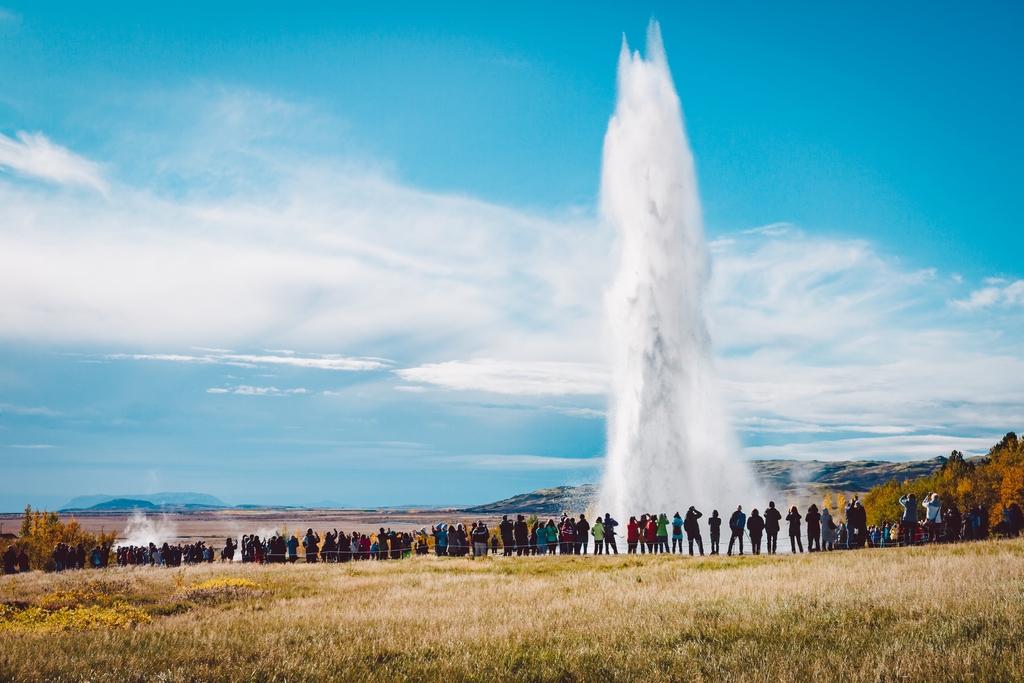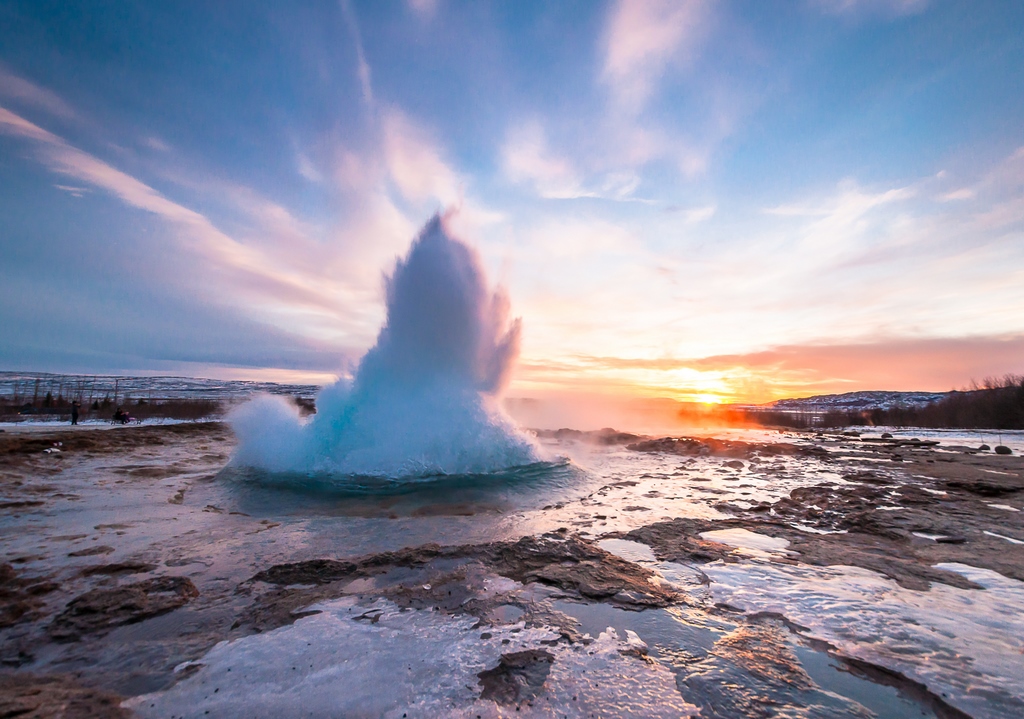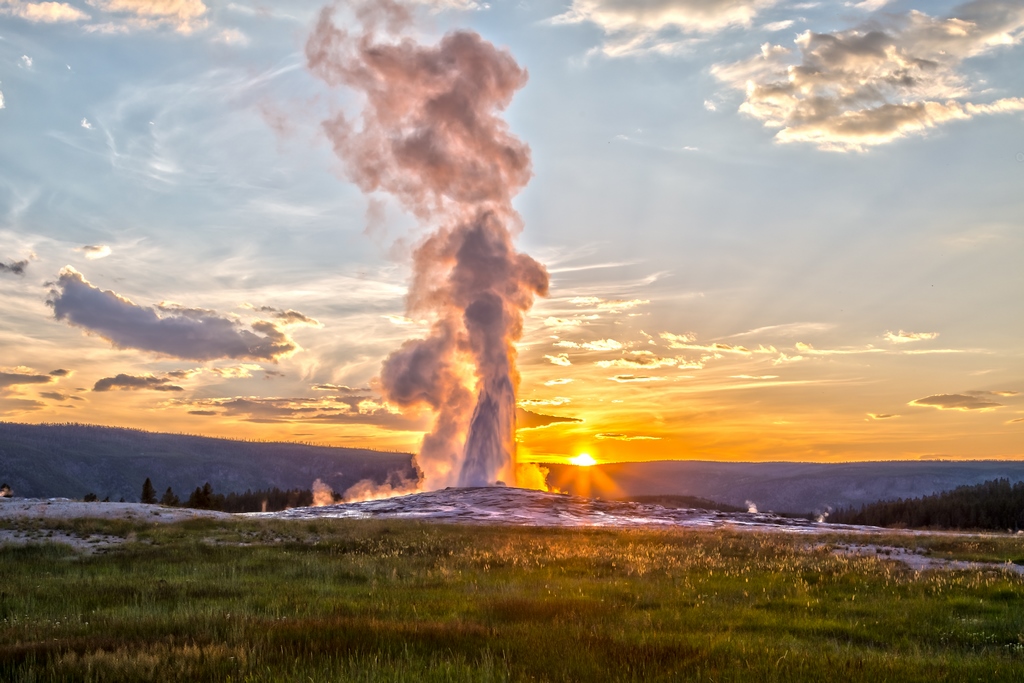The Fascinating World of Geysers


Geysers stand out among nature’s most enigmatic and spectacular watershape wonders, inspiring awe as they shoot scalding water and steam into the air. But how do geysers work? What is the natural mechanism behind these showy geological marvels? Here’s a look beneath the surface.
By Worthy McCargo
If you’ve ever been to Yellowstone National Park and seen the geyser Old Faithful erupt on schedule, you know how fascinating and entertaining geysers can be. Among nature’s most animated geological features, geysers are direct evidence of the enormous power beneath our feet.
Geysers owe their existence to the Earth’s internal heat, the infinitely abundant geothermal energy emanating from the planet’s molten core, where temperatures can reach several thousand degrees Celsius. That heat energy gradually radiates outwards, warming the surrounding rock and groundwater, and powering a host of surface features including hot springs, boiling mud pots, superheated pools and geysers. (It is also the source of volcanoes and plate tectonics.)
Geysers require a set of balanced conditions that are relatively rare. According to geology.com, there are only about 1000 geysers in the world.
HIDDEN PROCESS
Here’s how geysers work:
Beneath the Earth’s surface, water collects in underground reservoirs, aquifers, sometimes thousands of feet below the ground. The water in these often-massive subterranean stores of H2O becomes superheated as it absorbs the Earth’s internal thermal energy, with temperatures often beyond boiling.
The key to a geyser’s impressive display is the battle between superheated water and the earth containing it.
It’s a battle of heat and pressure. Despite temperatures beyond the boiling point, the aquifer water remains in a liquid state due to the significant pressure inside the underground reservoirs. When this superheated water rises to the surface, the expanding water releases all that compressed energy, erupting, often in spectacular fashion.
But there’s more to it. Geysers have what amounts to a specialized plumbing system that distinguishes them from other hot springs. The heart of this system is the conduit, a narrow, vertical channel leading from the underground reservoir to the surface. The conduit acts as a pathway for the superheated water to escape.
As the scalding water makes its way through the conduit, the pressure increases. This pressure buildup is due to the water’s expansive steam generation, which occurs as the water approaches the surface and its temperature drops slightly. The pressure in the conduit becomes the driving force behind the geyser’s eruption.
At the surface, the geyser’s vent plays a crucial role in the eruption. The vent is often narrower than the conduit, serving as an additional restriction to the escaping water. Essentially a geological nozzle, the vent concentrates the kinetic energy of the rising water, increasing its speed and pressure.
ERUPTION SEQUENCE
When the pressure within the conduit becomes too great to be contained, the geyser erupts in a spectacular display of nature’s power. The superheated water and steam shoot out of the vent, reaching heights of tens of meters. This eruption can last for several minutes, making geysers one of the most remarkable and captivating natural wonders.
Following the eruption, the geyser’s underground plumbing system begins to recharge. Water from its aquifer begins to flow into the empty conduit, gradually refilling it. The heat from the Earth’s core continues to heat this replenishing water, setting the stage for the next eruption.
One of the fascinating aspects of geysers is their unpredictability. Not all geysers erupt at regular intervals like Old Faithful. Yes, some are highly predictable and follow a strict schedule; others, however, are far more sporadic and unpredictable, making them a challenging subject of study for geologists and a hit-and-miss proposition for tourists.
LONG RUNNING
Geysers are not static geological features; they evolve over time. The formation of a geyser requires a unique combination of geological conditions, including the aforementioned presence of underground reservoirs, a suitable conduit, and a constriction near the surface. Over thousands of years, these features can develop and change, eventually leading to the creation of a geyser, and eventually its demise because like all geological structures, they will eventually wither away.
Ultimately, geysers are a testament to the Earth’s geological complexity and the incredible forces at work beneath its surface. Understanding the mechanism behind geysers not only deepens our appreciation for them, but also sheds light on the Earth’s geothermal energy resources, which hold great potential for sustainable energy production.

STAR GEYSERS
Here are five of the world’s most famous geysers:
Old Faithful (Yellowstone National Park, USA)
Old Faithful is perhaps the most famous geyser in the world. It is known for its predictable and frequent eruptions, which occur approximately every 90 minutes. It can shoot hot water and steam up to 185 feet into the air.
Strokkur (Iceland)
Strokkur is one of Iceland’s most famous geysers and is located in the Geysir Geothermal Area. It erupts more frequently than many other geysers in the area, often every five-to-10 minutes, reaching heights of up to 100 feet.
Great Geysir (Iceland)
The Great Geysir is one of the oldest geysers known to Europeans and is the namesake for all other geysers. While it’s not as active as it once was, it can still erupt to impressive heights when it does.
Pohutu Geyser (Te Whakarewarewa Geothermal Valley, New Zealand)
Pohutu Geyser is the largest active geyser in the southern hemisphere. It erupts regularly, reaching heights of up to 100 feet, and is located in a geothermal wonderland.
Castle Geyser (Yellowstone National Park, USA)
Castle Geyser is known for its distinctive cone shape and impressive eruptions. It erupts less frequently than Old Faithful but can reach heights of up to 90 feet
There are also a number of man-made geysers, in which humans have either intentionally or accidentally tapped into super-heated ground water. Some watershapers believe that geysers were the original inspiration for modern fountains.
Worthy McCargo is a writer, actor, PR specialist and part-time bouncer based in Freeport, Long Island, NY.
Opening photo by Jakub Barzycki | Shutterstock; second photo by Zinaida Sopina | Shutterstock, lower photo by Susan Palmer | Shutterstock.











